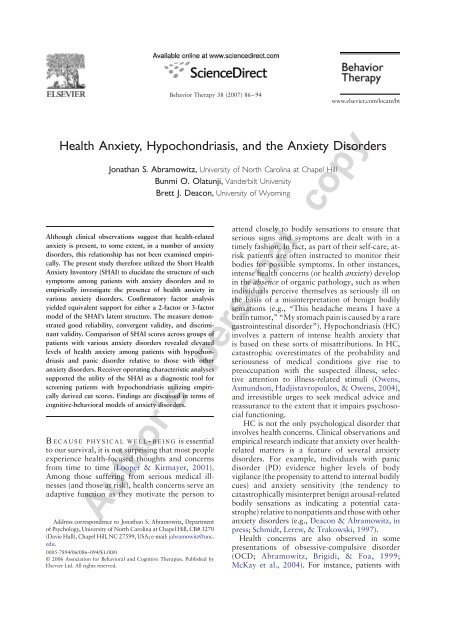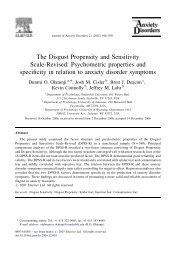Behavior Therapy 38 (2007) 86–94www.elsevier.com/locate/bt<strong>Health</strong> <strong>Anxiety</strong>, Hypochondriasis, and <strong>the</strong> <strong>Anxiety</strong> DisordersJonathan S. Abramowitz, <strong>University</strong> <strong>of</strong> North Carolina at Chapel HillBunmi O. Olatunji, Vanderbilt <strong>University</strong>Brett J. Deacon, <strong>University</strong> <strong>of</strong> <strong>Wyoming</strong>Although clinical observations suggest that health-relatedanxiety is present, to some extent, in a number <strong>of</strong> anxietydisorders, this relationship has not been examined empirically.The present study <strong>the</strong>refore utilized <strong>the</strong> Short <strong>Health</strong><strong>Anxiety</strong> <strong>Inventory</strong> (SHAI) to elucidate <strong>the</strong> structure <strong>of</strong> suchsymptoms among patients with anxiety disorders and toempirically investigate <strong>the</strong> presence <strong>of</strong> health anxiety invarious anxiety disorders. Confirmatory factor analysisyielded equivalent support for ei<strong>the</strong>r a 2-factor or 3-factormodel <strong>of</strong> <strong>the</strong> SHAI’s latent structure. The measure demonstratedgood reliability, convergent validity, and discriminantvalidity. Comparison <strong>of</strong> SHAI scores across groups <strong>of</strong>patients with various anxiety disorders revealed elevatedlevels <strong>of</strong> health anxiety among patients with hypochondriasisand panic disorder relative to those with o<strong>the</strong>ranxiety disorders. Receiver operating characteristic analysessupported <strong>the</strong> utility <strong>of</strong> <strong>the</strong> SHAI as a diagnostic tool forscreening patients with hypochondriasis utilizing empiricallyderived cut scores. Findings are discussed in terms <strong>of</strong>cognitive-behavioral models <strong>of</strong> anxiety disorders.B ECAUSE PHYSICAL WELL- BEING is essentialto our survival, it is not surprising that most peopleexperience health-focused thoughts and concernsfrom time to time (Looper & Kirmayer, 2001).Among those suffering from serious medical illnesses(and those at risk), health concerns serve anadaptive function as <strong>the</strong>y motivate <strong>the</strong> person toattend closely to bodily sensations to ensure thatserious signs and symptoms are dealt with in atimely fashion. In fact, as part <strong>of</strong> <strong>the</strong>ir self-care, atriskpatients are <strong>of</strong>ten instructed to monitor <strong>the</strong>irbodies for possible symptoms. In o<strong>the</strong>r instances,intense health concerns (or health anxiety) developin <strong>the</strong> absence <strong>of</strong> organic pathology, such as whenindividuals perceive <strong>the</strong>mselves as seriously ill on<strong>the</strong> basis <strong>of</strong> a misinterpretation <strong>of</strong> benign bodilysensations (e.g., “This headache means I have abrain tumor,” “My stomach pain is caused by a raregastrointestinal disorder”). Hypochondriasis (HC)involves a pattern <strong>of</strong> intense health anxiety thatis based on <strong>the</strong>se sorts <strong>of</strong> misattributions. In HC,catastrophic overestimates <strong>of</strong> <strong>the</strong> probability andseriousness <strong>of</strong> medical conditions give rise topreoccupation with <strong>the</strong> suspected illness, selectiveattention to illness-related stimuli (Owens,Asmundson, Hadjistavropoulos, & Owens, 2004),and irresistible urges to seek medical advice andreassurance to <strong>the</strong> extent that it impairs psychosocialfunctioning.HC is not <strong>the</strong> only psychological disorder thatinvolves health concerns. Clinical observations andempirical research indicate that anxiety over healthrelatedmatters is a feature <strong>of</strong> several anxietydisorders. For example, individuals with panicdisorder (PD) evidence higher levels <strong>of</strong> bodyvigilance (<strong>the</strong> propensity to attend to internal bodilycues) and anxiety sensitivity (<strong>the</strong> tendency tocatastrophically misinterpret benign arousal-relatedbodily sensations as indicating a potential catastrophe)relative to nonpatients and those with o<strong>the</strong>ranxiety disorders (e.g., Deacon & Abramowitz, inpress; Schmidt, Lerew, & Trakowski, 1997).<strong>Health</strong> concerns are also observed in somepresentations <strong>of</strong> obsessive-compulsive disorder(OCD; Abramowitz, Brigidi, & Foa, 1999;McKay et al., 2004). For instance, patients withAuthor's personal copyAddress correspondence to Jonathan S. Abramowitz, Department<strong>of</strong> Psychology, <strong>University</strong> <strong>of</strong> North Carolina at Chapel Hill, CB# 3270(Davie Hall), Chapel Hill, NC 27599, USA; e-mail: jabramowitz@unc.edu.0005-7894/06/086–094/$1.00/0© 2006 Association for Behavioral and Cognitive Therapies. Published byElsevier Ltd. All rights reserved.
health anxiety87contamination fears evidence obsessional images<strong>of</strong> germs and fears <strong>of</strong> illnesses, passive avoidance<strong>of</strong> situations in which germs might be present (e.g.,floors), and compulsive rituals focused on preventingillnesses (e.g., excessive handwashing).Individuals with generalized anxiety disorder(GAD) <strong>of</strong>ten display excessive and persistentworries about <strong>the</strong>ir health, along with o<strong>the</strong>r lifeevents and circumstances such as safety, relationships,and finances (American Psychiatric Association,2000). Finally, some types <strong>of</strong> specific phobias(i.e., illness phobia) involve irrational fear andavoidance <strong>of</strong> particular health-relevant stimuli andsituations that are reminders <strong>of</strong> illnesses, or thatare believed to increase <strong>the</strong> risk <strong>of</strong> becoming ill(e.g., hospitals, public bathrooms; Marks, 1987).Despite <strong>the</strong> prominence <strong>of</strong> health concerns acrossa variety <strong>of</strong> conditions, no research has directlycompared levels <strong>of</strong> health anxiety in groups <strong>of</strong>individuals with different anxiety disorders. Forseveral reasons, understanding <strong>the</strong> degree to whichhealth anxiety is present across <strong>the</strong> anxiety disordersis <strong>of</strong> particular interest. For instance, a clearerunderstanding <strong>of</strong> <strong>the</strong> role <strong>of</strong> health anxiety wouldinform unifying <strong>the</strong>ories and transdiagnostic treatments<strong>of</strong> anxiety disorders (e.g., Harvey, Watkins,Mansell, & Shafran, 2004; Norton, Hayes, &Hope, 2004), which conceptualize <strong>the</strong>se syndromesas heterogeneous presentations <strong>of</strong> <strong>the</strong> same underlyingpsychological mechanisms. Given that <strong>the</strong>innate function <strong>of</strong> anxiety is to protect <strong>the</strong> organismagainst injury and harm, it would not be surprisingif health concerns emerged as a common denominator<strong>of</strong> many topographically diverse anxietystates. Research also indicates that <strong>the</strong> assessment<strong>of</strong> health anxiety is clinically valuable, over andabove o<strong>the</strong>r variables (e.g., anxiety sensitivity), in<strong>the</strong> diagnosis <strong>of</strong> anxiety conditions (e.g., Schmidt,Joiner, Staab, & Williams, 2003) and that actualand perceived health concerns are associated withattenuated treatment outcome (e.g., Schmidt &Telch, 1997). Perhaps health anxiety is also aprognostic indicator for o<strong>the</strong>r anxiety disorders.One explanation for <strong>the</strong> lack <strong>of</strong> research on healthanxiety is that psychometrically sound measures <strong>of</strong>this construct have not been available. Recently,however, Salkovskis, Rimes, Warwick, and Clark(2002) <strong>introduced</strong> <strong>the</strong> <strong>Health</strong> <strong>Anxiety</strong> <strong>Inventory</strong>(HAI) and its abbreviated form, <strong>the</strong> Short HAI(SHAI). In an initial study, Salkovskis et al. (2002)reported that <strong>the</strong> 64-item HAI showed adequateinternal consistency (α range=.71 to .92) and testretestreliability (r=.90 over 1 week) in a sample <strong>of</strong>HC patients. The 18-item SHAI evidenced comparablereliability (α=.89) and validity, and thus (dueto its brevity) is a more practical measure for clinicaland research purposes. Salkovskis et al. (2002)reported that <strong>the</strong> SHAI consists <strong>of</strong> two factorsassessing (a) <strong>the</strong> perceived likelihood <strong>of</strong> becomingseriously ill (“illness likelihood”), and (b) <strong>the</strong>perceived negative consequences <strong>of</strong> being seriouslyill (“negative consequences”). They did not, however,report <strong>the</strong> pertinent factor analytic results (e.g.,factor loadings) in <strong>the</strong>ir paper.In a subsequent study evaluating <strong>the</strong> psychometricproperties and factor structure <strong>of</strong> <strong>the</strong> SHAI in anonclinical sample, we (Abramowitz, Deacon, &Valentiner, in press) also found evidence <strong>of</strong> soundpsychometrics (α=.86). Exploratory factor analysis,however, revealed three factors assessing (a) <strong>the</strong>perceived likelihood <strong>of</strong> becoming ill, (b) <strong>the</strong> perceivednegative consequences <strong>of</strong> becoming ill, and (c) bodyvigilance. The negative consequences factor overlappedentirely with that identified by Salkovskis et al.Taken toge<strong>the</strong>r, <strong>the</strong>se two studies indicate that healthanxiety as assessed by <strong>the</strong> SHAI is multidimensionaland suggest that fur<strong>the</strong>r research is needed toelucidate <strong>the</strong> factor structure <strong>of</strong> this instrument.The prominence <strong>of</strong> health concerns in variousanxiety disorders highlights <strong>the</strong> importance <strong>of</strong> areliable and valid measure <strong>of</strong> health anxiety inclinical samples. The present study <strong>the</strong>refore hadtwo goals. First, we examined <strong>the</strong> factor structure,psychometric properties, and correlates <strong>of</strong> <strong>the</strong> SHAIin a large sample <strong>of</strong> individuals with clinical anxiety(including those with HC). After examining <strong>the</strong>SHAI’s internal consistency and item-total correlations,we conducted confirmatory factor analyses(CFA) comparing <strong>the</strong> goodness <strong>of</strong> fit <strong>of</strong> competingfactor models. The SHAI’s convergent and divergentvalidity with respect to existing measures <strong>of</strong> anxietyrelatedpsychopathology was also examined. Consistentwith previous work, we predicted that <strong>the</strong>SHAI would (a) best fit ei<strong>the</strong>r a two- or three-factormodel including factors assessing illness likelihood,negative consequences <strong>of</strong> having an illness, andperhaps body vigilance, and (b) demonstrate apattern <strong>of</strong> <strong>the</strong>oretically consistent relationshipswith measures <strong>of</strong> anxiety-related symptoms.The second aim <strong>of</strong> <strong>the</strong> present study was toexamine <strong>the</strong> phenomenon <strong>of</strong> health anxiety acrossseveral anxiety disorders. On <strong>the</strong> basis <strong>of</strong> previousconceptual and empirical work (Salkovskis et al.,2002), we predicted that patients with HC wouldevidence elevated health anxiety compared tothose with anxiety disorders. We also examined<strong>the</strong> SHAI’s utility as a diagnostic instrument forHC. The differential diagnosis <strong>of</strong> PD and HC canbe complicated as both disorders are characterizedby health-related fears, body vigilance, and effortsto avoid or seek assurance from medical sources(e.g., Hiller, Leibbrand, Rief, & Fichter, 2005).Author's personal copy




